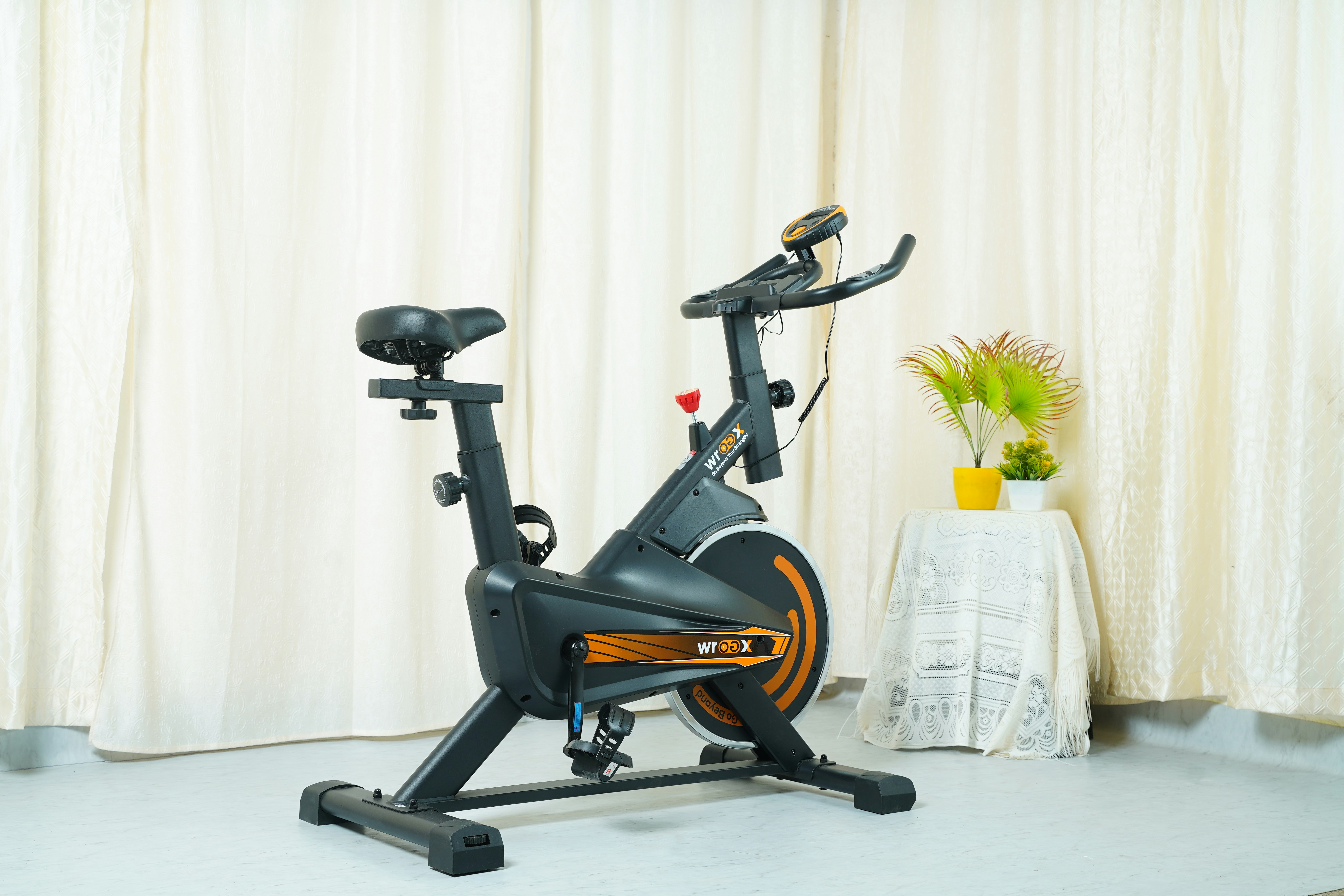
Photo by Andrew Valdivia on Unsplash
Cardiovascular fitness, the efficiency with which your heart, lungs, and vascular system work during exercise, is crucial for overall health. Using a stationary bike is an effective method for enhancing cardiovascular health. This form of exercise raises your heart rate while minimizing stress on your joints, making it suitable for a wide range of individuals.
Regular sessions on a stationary bike can significantly improve heart health. Studies suggest that engaging in moderate-intensity cycling can reduce the risk of heart disease by up to 15% Centers for Disease Control and Prevention. Furthermore, stationary biking helps to improve endurance and stamina, allowing your body to perform activities for longer without fatigue.
This exercise tool also supports weight management. A 30-minute ride can burn between 200 to 300 calories, dependent on the intensity and the rider’s weight, thus assisting in maintaining a healthy weight range which is vital for cardiovascular health.
For those interested in blending their workout routines, incorporating sessions on a stationary bike can be beneficial. More information on how mixed cardio routines can enhance fitness outcomes can be found at What is Mixed Cardio on Apple Watch. This info shows different ways to integrate cycling into a broader exercise regimen, offering variety that can help maintain long-term engagement and results.
Core Benefits: Why Stationary Biking is Great for Cardio
Stationary biking offers numerous cardiovascular benefits that make it an excellent choice for maintaining and improving heart health. Riding a stationary bike regularly can significantly strengthen your heart and lungs, boosting overall cardiovascular fitness. This form of exercise enhances the circulation of blood and oxygen throughout your body, which has a host of health benefits. For instance, improved cardio fitness can lead to better brain functioning and memory, lower blood pressure, enhanced sleep quality, and more stable blood sugar levels. Furthermore, it boosts the immune system, energy levels, and mood while reducing stress levels (Penn State PRO Wellness).
One of the standout advantages of stationary biking is its capacity for substantial calorie burn, making it a dynamic tool for weight management. Depending on your workout intensity and body weight, a session on a stationary bike can burn upwards of 600 calories per hour. This effective calorie burn aids significantly in weight loss and fat reduction when coupled with a balanced diet. Added to these benefits are the muscle-strengthening aspects of the workout, particularly for the legs and lower body muscles like calves, hamstrings, and quadriceps, without putting undue stress on the joints.
For more insights into how different cardio workouts compare in terms of calorie expenditure, refer to our detailed analysis here.
Stationary biking is an accommodating and safe exercise option that manages to deliver intense workout benefits while being kind to your body, particularly the joints. Whether you aim to improve heart health, lose weight, or strengthen muscles, stationary biking merits consideration as a core component of your fitness regime.
Adjusting Your Bike for Maximum Cardio Output

Photo by Intenza Fitness on Unsplash
To optimize your bike for the best cardio workout, paying attention to various settings is crucial. One of the simplest modifications you can make to increase output is to adjust your riding gear. Advances in bike design allow riders to select gears that enhance their power output without altering their cadence. For instance, if you normally ascend a hill using a 34 x 19 gear ratio, try shifting to a 34 x 17. Increasing the gear ratio, even slightly, means you’ll generate more power over the same distance, effectively boosting your workout’s cardio element (TrainingPeaks).
The setup also involves a correct seating position. Ensure that your bike seat and handlebars are adjusted so you can pedal comfortably without straining your back. The seat height should allow a slight bend in the knee at the bottom of the pedal stroke. Correct posture is vital to avoid injury and fatigue, letting you ride longer and with more intensity.
By properly adjusting your bike’s physical settings and gearing, not only can you increase your cardiovascular output, but you can also make your training sessions more effective and enjoyable. For those particularly interested in enhancing endurance through cycling, consider reading about zone 2 cardio workouts on our article about What is Zone 2 Cardio, which details workouts optimizing heart rate and endurance capabilities.
Techniques for Enhancing Cardio Effectiveness on a Stationary Bike
To optimize your cardio workout on a stationary bike, consider integrating interval training into your routine. Interval training involves alternating periods of high intensity with periods of recovery, which can significantly enhance cardiovascular fitness and calorie burn. Start with a warm-up by cycling at a low intensity for the first five minutes. After warming up, pedal vigorously for one minute, then switch back to a lighter pace for one minute to recover. Repeat this cycle 8 to 10 times before ending with a five-minute cooldown to gradually bring your heart rate down. This approach helps improve endurance and can contribute to more effective fat loss.
For those aiming for consistent growth in their cardiovascular strength, gradually increase the duration of the high-intensity segments while decreasing the recovery time between intervals. This method not only boosts cardiovascular health but also maintains engagement by breaking the monotony of a steady pace.
Additionally, selecting a bike that offers adjustable resistance levels allows you to tailor the workout intensity to match your fitness level, making your sessions more effective. The American Council on Exercise highlights the benefits of interval training in maximizing cardiovascular health while helping to prevent burnout (Phil Verstraete, 2020).
For further reading on how to effectively use your stationary bike, visit our detailed guide on exercise bike interval training.
High-Intensity Interval Training (HIIT) on Stationary Bikes

Photo by Abhishek Dutta on Unsplash
High-Intensity Interval Training, or HIIT, on stationary bikes is a highly efficient workout strategy, especially appealing for those with limited time. This form of exercise involves short bursts of intense activity followed by brief recovery periods, enabling a quick and impactful session—often completed in less than 30 minutes.
One of the standout benefits of HIIT on a stationary bike is its time efficiency. According to a 2021 study, engaging in regular low-volume HIIT sessions can significantly enhance cardiorespiratory fitness and improve health markers such as blood pressure and blood sugar levels (Anytime Fitness, 2023). Furthermore, HIIT helps maintain a higher calorie burn rate even after the workout is over, a phenomenon known as post-exercise resting energy expenditure.
HIIT workouts on stationary bikes can be tailored to various fitness levels and offer substantial health rewards without the high impact of some other forms of exercise. This makes it an attractive option for improving cardiovascular health and increasing stamina owing to the enhanced oxygen utilization (VO2 max) it promotes.
By incorporating sessions of HIIT on your stationary bike, you can achieve rapid improvements in health and fitness, making each workout session both effective and efficient.
Long-Term Cardiovascular Benefits of Regular Stationary Biking
Regular stationary biking is a highly effective way to improve cardiovascular health over the long term. Engaging in consistent indoor cycling activities can lead to significant enhancements in heart function, aerobic capacity, and blood pressure control.
A systematic review found that stationary biking could significantly improve aerobic capacity, which is a key indicator of cardiovascular health. This improvement is measured by increased maximal oxygen consumption (VO2 max), a critical factor that illustrates how well the heart and lungs can supply oxygen to muscles during sustained exercise Chavarrias et al., 2019. Over time, this enhancement can lead to better endurance and less fatigue during physical activities.
Additionally, regular engagement with a stationary bike has been shown to contribute effectively to blood pressure management. Long-term stationary biking can help in lowering both systolic and diastolic blood pressure, which are important markers for cardiovascular risk. Lower blood pressure reduces the strain on the heart and arteries, preventing long-term wear and tear and decreasing the likelihood of strokes and heart attacks.
Stationary biking also helps in maintaining a healthy lipid profile by improving levels of HDL (high-density lipoprotein), known as “good cholesterol,” and reducing levels of LDL (low-density lipoprotein) or “bad cholesterol.” These changes in blood lipids contribute to the prevention of atherosclerosis and coronary heart disease.
For those seeking comprehensive fitness guidance, integrating stationary biking into a well-rounded exercise routine can amplify these cardiovascular benefits. Engaging with other cardio exercises on our platform can provide varied and additional advantages, catering to a full spectrum of fitness goals.
In conclusion, making stationary biking a regular part of your fitness regimen can significantly bolster your cardiovascular health, making it an indispensable activity for long-term wellness.
Common Myths and Facts About Stationary Biking and Cardio
When it comes to stationary biking and its benefits for cardiovascular health, there are several common myths that need addressing. Firstly, many believe that cardio should be the sole focus of a workout regimen. However, integrating various activities, such as stretching and yoga, can also support cardiovascular health by helping manage blood pressure and maintaining heart health Peloton.
Another prevalent myth is the notion that cardio sessions need to last at least an hour to be effective. This isn’t necessarily true. Even short bursts of activity, such as a 15-minute ride, can be significantly beneficial, especially for those with tight schedules. It’s all about making exercise fit into your daily routine rather than feeling discouraged by not hitting the one-hour mark immediately.
Furthermore, the idea that more intense and prolonged cardio sessions always lead to better health is a misconception. While sustained exercise has its benefits, excessive cardio without proper recovery can lead to heart strain and other health issues. Therefore, it’s crucial to find a balance and include moderate-intensity workouts as part of your exercise routine.
For those interested in optimizing their stationary biking for heart health, considering the balance of workout intensity and duration alongside incorporating variety in exercises can make a substantial difference. For more insights on optimizing your routine, check out our guide on How Much Cardio Should I Do a Week When Trying to Build Muscle.
Summary: Making the Most of Your Stationary Bike for Cardio Health
Utilizing a stationary bike provides a remarkable opportunity to boost your cardiovascular fitness from the comfort of your home. It’s essential to use equipment that aids in monitoring your heart’s health during workouts. An example highlighted by Ariane Resnick’s experience on CNET shows the value of integrated heart rate monitors. These devices allow users to track heart rate real-time, ensuring exercises are conducted within safe heart rate zones without overexerting, which is crucial for those with specific health conditions.
Stationary biking allows for adjustable resistance levels, which can be tailored to your fitness goals and current health. Whether it is enhancing endurance or improving heart health, the ability to adjust the intensity helps you gradually increase your cardiovascular ability at a sustainable pace. Regular workouts, tracked properly, lead to a consistent increase in heart health and overall fitness.
For those specifically looking to enhance calorie-burning, combining your bike workouts with other forms might prove beneficial. Exploring resources like our guide on other effective cardio machine workouts can provide insights and add variety to your exercises.
In summary, to make the most out of your stationary bike for enhancing cardio health, ensure you use heart rate monitors to maintain optimal intensity, adjust resistance levels according to your physical capacity, and integrate diverse workouts for balanced fitness development.